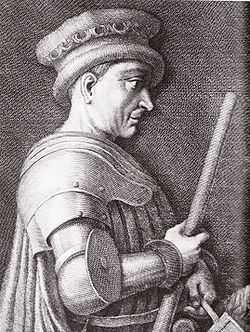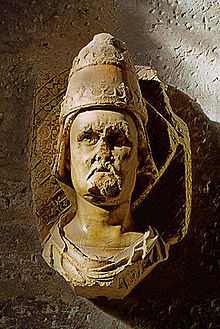War of the Eight Saints
| War of the Eight Saints | |||||||
|---|---|---|---|---|---|---|---|
| |||||||
| Belligerents | |||||||
|
|
Coalition of Italian city-states: | ||||||
| Commanders and leaders | |||||||
|
John Hawkwood α Robert of Geneva β | Otto della guerra | ||||||
| αUntil 1377 βFrom 1377 | |||||||
The War of the Eight Saints (1375–1378) was a war between Pope Gregory XI and a coalition of Italian city-states led by Florence, which contributed to the end of the Avignon Papacy.
Causes

The causes of the war were rooted in interrelated issues, Florentine opposition to the expansion of the Papal States in central Italy (which the Avignon Popes had set as a condition for their return), and antipathy toward the Parte Guelfa in Florence.[1] Specifically, Florence feared in the autumn of 1372 that Gregory XI intended to reoccupy a strip of territory near Lunigiana, which Florence had conquered from Bernabò Visconti, and that the Ubaldini might switch from Florentine to Papal allegiance.[2]
Gregory XI also harbored various grievances against Florence for their refusal to aid him directly in his war against the Visconti of Milan.[2] When Gregory XI's war against Milan ended in 1375, many Florentines feared that the pope would turn his military attention toward Tuscany; thus, Florence paid off Gregory XI's main military commander, English condottiere John Hawkwood, with 130,000 florins, extracted from local clergy, bishops, abbots, monasteries, and ecclesiastical institutions, by an eight-member committee appointed by the Signoria of Florence, the otto dei preti.[3] Hawkwood also received a 600 florin annual salary for the next five years and a lifetime annual pension of 1,200 florins.[4]
The transalpine mercenaries employed by Gregory XI against Milan, now unemployed, were often a source of friction and conflict in papal towns.[5]
The War

Florence formed an alliance with Milan in July 1375, immediately prior to the outbreak of the war, and the prosecution of the war was entirely delegated to an eight-member committee appointed by the Signoria of Florence: the otto della guerra.[3]
Florence incited a revolt in the Papal States in 1375. Florentine agents were sent to more than forty cities in the papal states—including Bologna, Perugia, Orvieto, and Viterbo—to foment rebellion, many of which had only been re-submitted to papal authority by the efforts of Cardinal Gil Álvarez Carrillo de Albornoz.[3] Humanist Chancellor of Florence Coluccio Salutati disseminated public letters urging the cities to rebel against the "tyrannical" and "corrupt" papal rule, instead urging a return to all'antica Republicanism.[3]

Pope Gregory XI excommunicated all members of the government of Florence and placed the city under interdict on March 31, 1376,[6] banning religious services in Florence and legalizing the arrest and enslavement[7] of Florentines and the confiscation of their property throughout Europe.[3] Initially, rather than attempting to disobey the interdict, Florentines organized extra-ecclesiastical processions (including flagellants) and confraternities, including the re-emergence of groups such as the Fraticelli, who had previously been deemed heretical.[3] The edifice of the Florentine inquisition was destroyed, and the Signoria rolled back legal restrictions on usury and other practices frowned on by the (now defunct) ecclesiastical courts.[8]
However, on October 1377, the government of Florence forced the clergy to resume religious services causing Angelo Ricasoli, Bishop of Florence, and Neri Corsini, Bishop of Fiesole, to flee Florentine territory.[3] The heavy fines and confiscations issued by the Signoria on prelates who left their posts,[3] the "most extensive liquidation of an ecclesiastical patrimony attempted anywhere in Europe before the Reformation," may have been motivated to pay for the increasingly expensive conflict.[1] The total cost of the war for Florence would reach approximately 2.5 million florins.[9]
As a result of Gregory XI's economic sanctions, merchants of the Florentine "diaspora" were hurt economically throughout Europe, particularly the Alberti bankers in Avignon, although the interdict was ignored by many, including Charles V of France.[3]
Hawkwood honored his agreement with the Florentines not to make war in Tuscany, limiting himself to putting down the various rebellions within the papal states; in 1377 Hawkwood abandoned Gregory XI entirely and joined the anti-papal coalition.[3] Gregory XI's other condottieri also limited their activities to Romagna, notably sacking Cesena in February 1377.[3] In the spring of 1377, papal mercenaries recaptured Bologna, which up until that point had been a key Florentine ally.[3]
In 1377, Cardinal Robert of Geneva (future Avignon Pope Clement VII) led the army of Gregory XI in an attempt to quell the revolt, and Gregory XI himself returned to Italy to secure his Roman possessions, de facto ending the Avignon Papacy. Gregory XI arrived in Rome in January 1378, after a difficult journey (including shipwreck), and died there in March 1378.[5]
Resolution
The war ended with a peace treaty concluded at Tivoli in July 1378, negotiated with Pope Urban VI following the death of Gregory XI and with the beginning of the Western Schism.[1] Under the treaty, Florence was to pay the Pope 200,000 florins (as opposed to Pope Gregory XI's original indemnity requirement of 1,000,000 florins[3]), repeal all laws placed against the Church by the secular government, and restore all property confiscated or looted from the clergy. The Pope, in return, was to repeal the interdict placed on Florence and mend the ecclesiastical community's diminished favor of Florence.[10]
The Eight Saints

The Eight Saints (Italian: otto di santi) may refer to one or both of two, eight-member balía appointed by the Signoria of Florence during the war.[6] When Florence arranged a nonaggression pact with Hawkwood at a cost of 130,000 florins, a special commission of eight citizens was created to levy a one-year, forced loan on the clergy of Florence and Fiesole to cover the sum. A second council of eight men was later created to make the military and diplomatic arrangements necessary to carry on a war against the Pope.[3]
The group identity of the Eight Saints remains a controversial subject. The levy committee is most widely accepted as the otto di santi by scholars, though some argue that otto di santi refers to the war council.[6] The first historical reference to the Eight of War (Italian: otto della guerra) as the otto santi occurs in 1445 with the account of Florentine historian Domenico Buoninsegni; it does not appear in the accounts of contemporaries of the war such as Leonardo Bruni and Giovanni Morelli.[6] Buoninsegni had applied the appellation—used in August 1378 to refer to an eight-member group (Gli Otto Santi del Popolo di Dio) formed by the Ciompi revolt, which ensued immediately after the War of the Eight Saints—to the otto della guerra. In contrast, the moniker is used in the March 31, 1376 bull of excommunication to refer to the otto dei preti (the levy committee, literally meaning "eight priests").[6]
The otto dei preti, appointed July 7, 1375 to carry out the taxation of the clergy for the nonaggression pact included:
|
|
The otto della guerra (war council) were appointed August 14, 1376 and consisted of four guild representatives and four members of the nobility.[3]
|
Major Guild Representatives
Minor Guild Representatives |
Members of Elite Florentine Families[3]
|
See also
References
- ↑ 1.0 1.1 1.2 Peterson, David S. 2002. "The War of the Eight Saints in Florentine Memory and Oblivion." In Society and Individual in Renaissance Florence, Ed. William J. Connell.
- ↑ 2.0 2.1 Lewin, Alison Williams. 2003. Negotiating Survival: Florence and the Great Schism, 1378-1417. Fairleigh Dickinson University Press. ISBN 0-8386-3940-2. pp. 39-56.
- ↑ 3.0 3.1 3.2 3.3 3.4 3.5 3.6 3.7 3.8 3.9 3.10 3.11 3.12 3.13 3.14 3.15 3.16 3.17 3.18 Najemy, John M. 2006. A History of Florence 1200-1575. Blackwell Publishing. ISBN 1-4051-1954-3. pp. 151-155.
- ↑ Caferro, William. 2006. John Hawkwood: An English Mercenary in Fourteenth-Century Italy. Baltimore: The Johns Hopkins University Press. ISBN 0-8018-8323-7. p. 175.
- ↑ 5.0 5.1 Holmes, George. 2000. Europe: Hierarchy and Revolt, 1320-1450. Blackwell Publishing. ISBN 0-631-21382-1. p. 131.
- ↑ 6.0 6.1 6.2 6.3 6.4 Trexler, R.C. 1963. "Who were the Eight Saints?" Renaissance News. 16, 2: 89-94.
- ↑ Alison Williams Lewin, Negotiating Survival: Florence and the Great Schism, 1378-1417 (Fairleigh Dickinson UP, 2003), p. 45, citing Gene A. Brucker, Florentine Politics and Society, 1343-1378 (Princeton UP, 1962), p. 310.
- ↑ Becker, Marvin B. 1959. "Florentine Politics and the Diffusion of Heresy in the Trecento: A Socioeconomic Inquiry." Speculum. 34, 1: 60-75.
- ↑ Procacci, Giuliano. 1970. History of the Italian People. Weidenfeld & Nicolson. p. 48.
- ↑ Francis A. Hyett. Florence: her history and art, to the fall of the Republic, (Methuen & Co., Trinity Hall, Cambridge: 1903), 182.
Further reading
- Chambers, D.S. 2006. Popes, Cardinals & War: The Military Church in Renaissance and Early Modern Europe. I.B. Tauris. ISBN 1-84511-178-8. p. 32-33.